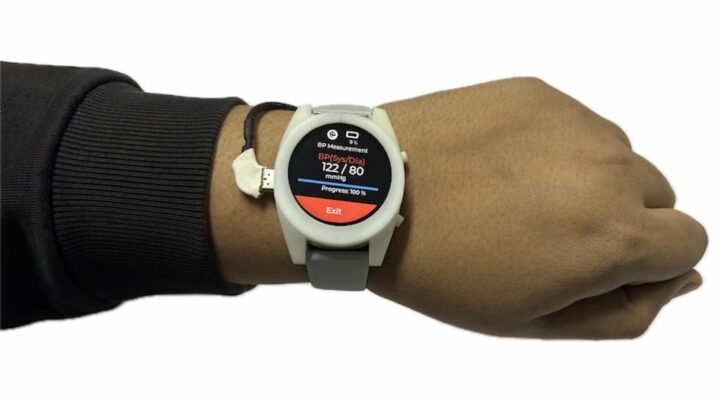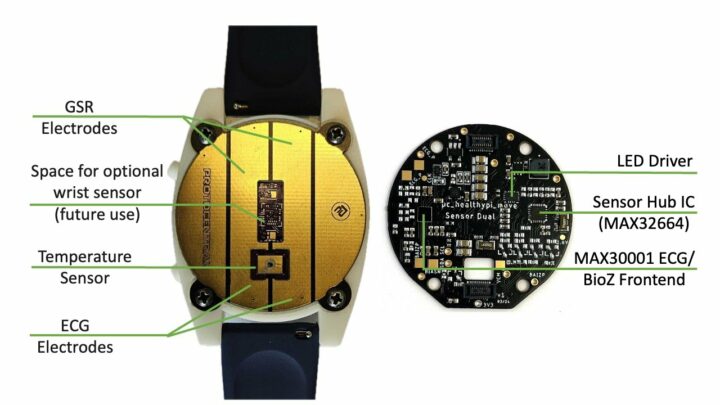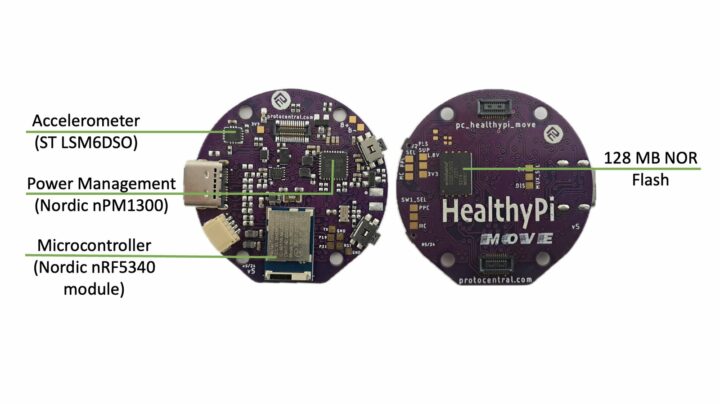The HealthyPi Move is the latest biometric monitor in the HealthyPi series from ProtoCentral. It is the first to come in a wearable form factor and can measure up to eight vital signs.
It is powered by a Nordic Semiconductor nRF5340 dual-core SoC, with a Cortex-M33 application processor and a Cortex-M33 network processor. It features 128MB of flash memory connected through a high-speed QSPI interface that can store up to 10 days of processed data.
It is capable of measuring galvanic skin response (EDA/GSR), electrocardiogram (ECG) signals, and photoplethysmogram (PPG) signals for determining blood oxygen level (SPO2), blood pressure, and heart rate variability. It also includes a body temperature sensor and inertial measurement unit (IMU) with a 6-axis accelerometer and gyroscope.
HealthyPi Move targets medical and biotech applications, including personal health tracking, building healthcare devices, and even clinical research with approval from the FDA or IRB.
We have previously covered other products in the HealthyPi series including the HealthyPi 5, HealthyPi v4, and HealthyPi Raspberry Pi HAT, as well as other ProtoCentral products outside the HealthyPi line such as the HeartyPatch and the Sensything ESP32 board.
HealthyPi Move specifications:
- MCU – Nordic Semiconductor nRF5340 dual-core Arm Cortex-M33, Bluetooth 5.4 SoC
- Memory – 128MB NOR QSPI flash memory for data storage
- Display – 1.28 inch TFT display with capacitive touchscreen
- Sensors
- ECG and bio-impedance front-end
- MAX30102 Optical PPG Sensor
- MAX32664 Sensor Hub with an accelerometer for motion compensation
- LSM6DSO 6-DoF IMU
- MAX30205 Body Temperature Sensor
- Parameters Monitored – ECG, Heart-rate and Heart-rate variability (HRV), PPG (from finger contact), SpO (from finger contact), Blood Pressure (from finger contact), EDA/GSR, Respiration Rate (ECG derived), Temperature
- Connectivity
- BLE 5.2
- USB Type-C for data transfer, charging, JTAG, and UART access (via USB Type-C Debug Accessory Mode)
- Misc
- 2x side push buttons for user input
- On-board real-time clock with super-capacitor backup
- Power management
- Nordic nPM1300 single chip PMIC
- Integrated 800 mA battery charger with USB Type-C Power Delivery support
- 2x programmable buck converters for efficient power management
- Fuel gauge for battery monitoring
- Load switches for selective power management
- 200 mAh Li-Po battery
- USB Type-C charging port
- Dimensions – 43mm diameter, 16mm thickness, compatible with 22mm watch straps
The HealthyPi Move’s firmware is based on Zephyr RTOS and nRF Connect SDK. It also has a companion app, OpenView2, written in Flutter and available for Android, macOS, Windows, and Linux operating systems.
You can program the HealthyPi Move using OTA upgrades from the Healthy Pi companion app or by connecting it to a computer via the USB interface. You can program the nRF5340 directly with an nRF development kit or any J-Link programmer by connecting the SWD (Serial Wire Debug) pins to the USB-C adapter board in the box.
It is completely open-source, and the hardware files and software are publicly available and hosted on GitHub. You can back the project for $249 on Crowd Suply and get a HealthyPi Move watch with a USB Type-C finger sensor and a SWD-to-USB programming adapter. Rewards are expected to ship by November 11, 2024.

Tomisin is a writer specializing in hardware product reviews, comparisons, and explainers. He is very passionate about small form factor and single-board computers.
Support CNX Software! Donate via cryptocurrencies, become a Patron on Patreon, or purchase goods on Amazon or Aliexpress







